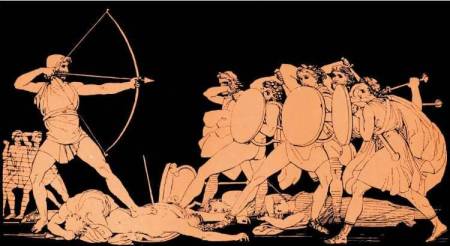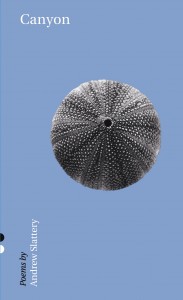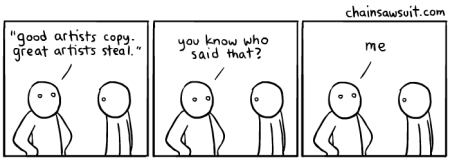‘That’s What He Said’: WhatCulture, Australian Poetry, and Plagiarism
IMAGE: Odysseus Confronts the Suitors
There’s a sign on my office door that depicts Odysseus in his moment of merciless slaughter. It’s an image taken from an ancient Greek vase. There’s no gore or viscera, or even facial expressions, merely rudimentary silhouetted shapes against a stark burnt umber backdrop; and yet the ghoulish subject of the scene is wholly unnerving nonetheless. It takes place at the conclusion of The Odyssey. Odysseus stands in front an exit that he has just locked shut, towering, unyielding, as he rains down a barrage of arrows upon the throng of suitors that have plagued his home for years. Seen in profile, Odysseus towers on one side of the picture, a man whose mettle has been tested, the bow in his hand flashing as his victims squeal and gnash their teeth in a wild clamour, their desperate pleading only cut short by the cold reprieve of an inexorable death.
Beneath the image I have written:
‘Dr Dray Explains His Policy On Plagiarism.’
I put it up as a playful warning to my students, situating it about eye height for anyone who would come to knock on my door. It’s an image so hyperbolically visceral and ferocious that it would elicit chuckles, and that will (hopefully) stick in their mind once the gag subsides.
The only thing is – I’m not really joking.
Okay, sure, when I encounter plagiarism I don’t string a mighty bow and block up the doors, but I do find it inexcusable. And if it proves to be methodical, and not accidental, it becomes unforgivable, and the slaughter – metaphorical or no – begins.
Because, both as an academic and a writer, the idea of knowingly thieving another person’s work, claiming ownership of thought and creative practice without even attribution or acknowledgement, strikes me as the most vile act anyone who claims to be a writer can perform. An act of arrogance and laziness and shamelessness, it forever tarnishes the perpetrator, proving that they have no regard for their victims, their readers, or even themselves.
While I wish this post were just an arbitrary listing of things I hate (aren’t they always fun?), it is, sadly, motivated by two recent grotesque and glaring examples of such fraudulence within circles I have frequented.
So journey with me, won’t you, as we take a magical ride through the tragically proliferating culture of flagrant plagiarism…
Firstly, at the WhatCulture website.
For those unaware, I actually used to write for WhatCulture. Well, when I say ‘write’ for them, I should clarify: I would write articles for my Themenastics blog, but would later contribute some of them to be republished there. There was no payment or expectation of first-publication, so I didn’t feel conflicted in repurposing my own work.
(It has since been discovered that WhatCulture was, for a period, openly misleading potential contributors by advertising paid freelance writing positions through agencies such as the Mandy website, in order to attract writers to whom they would only offer unpaid work. This misbehaviour was completely unbeknownst to me (I had offered to contribute my pieces unpaid from the start), but Paul Martinovic, a freelance writer and blogger who was a victim of this deception, spoke of his experience having taken the WhatCulture editors’ bait.)
When I started submitting to WhatCulture, well over a year ago, it seemed a promising little start-up. The mission statement, to give a voice to fans of popular culture – film, television, music, comics – that would allow them to speak to the aspects of these fictions that they loved, ideally putting them into some kind of critical context, seemed worthy. Like an AV Club with more readership participation, it seemed inspiring that the editors were so eager to provide a platform for those enthusiasts who might otherwise have their opinion languish unseen.
As time went on, however, the quality of WhatCulture steadily declined into something that – even with my relatively superficial familiarity with the site – I scarcely recognised. It seemed to happily wallow (in many cases seemingly as a direct influence of one of the writers I am about to denounce) in a snide, click-baiting swamp of cheap titillation and contrarian bickering, repeatedly sacrificing editorial substance so as to chase minor controversy for page-hits by whatever means it could. Articles with little more than a thousand words of copy were suddenly being split into several pages that needed to be clicked through, literally just to artificially inflate the page traffic, and the site started running progressively more pieces such as ’10 Awful Movies You Only Watched For the Nude Scenes’ (with screen grabs and clips! Yay!), fan boy lures like ‘PS4: 10 Reasons It’ll Win Console War Over Xbox 720’ and ‘Xbox 720: 10 Reasons It’ll Win Console War Over PS4’, each of which was written by the same author (again, more on him in just a second), merely days apart, with only the names of the consoles swapped around. And who could forget the journalistic high water mark of ‘See The Newcastle City Wall Sex Picture Taken From WhatCulture’s Office’. An article that is exactly as pathetic and puerille as you might suspect it to be.
So despite continuing to happily produce columns for Themenastics (and now to contribute pieces to the online journal PopMatters), as time has gone on I have been less inclined to make my writings available to WhatCulture. It wasn’t an act of protest, or judgement – I am under absolutely no delusions that my work was in any way missed – I simply lost interest in their new unspoken mandate, hoping that they might pull out of this disheartening nosedive, but continuously discouraged by the material that I instead saw them promote.
And consistently, to my mind, the worst offender amongst this race toward mediocrity was WhatCulture’s senior (and therefore paid) film reviewer and contributor Shaun Munro. I had been struck by the inanity of some of Munro’s work – it was he who had copy-pasted his Xbox One vs Playstation 4 article with the names flipped – but as time wore on he seemed to use the site as his own toilet wall, listing actresses who, in his opinion, ‘desperately need to go nude’ in future (as opposed to his desperately needing to get a personal life), salivating over every scrap of Scarlet Johansson’s flesh he could track down before his (apparently highly anticipated) opportunity to see her naked in the film Under the Skin, and offering a breaking ‘Special Report’ after seeing said film, providing a detailed list of every body part and crevice he had personally spied with the kind of obsessive, lecherous specificity you would scarcely find outside a legal deposition testimony.
‘Let me tell you about the full frontal nudity I just saw… Cwwooaarrrrr…’ Truly, journalism at its finest.
It was therefore something of a surprise to learn, two weeks ago, that my opinion of Munro actually was able to sink even lower, as it turns out that these masturbatory jaunts were apparently the only material he can comfortably produce without resorting to theft.
IMAGE: Garfield by Jim Davis (21/4/2008)
As was revealed by a blogger named Sr. Mxy in an exhaustive Tumblr that still only catalogues a portion of his innumerable plagiarisms, Munro, along with another WhatCulture writer and associate editor, T.J. Barnard (also a paid contributor), had been stealing work from the Cracked website and passing it off as their own. What made it an even more pernicious act was that the material they were helping themselves to was in a draft form, and had therefore not yet been published. Part of the Cracked editorial process apparently involves submitting outlines and edits into an online workshop system that can only be accessed by contributors to the site and its editors; Munro and Barnard, who each had access to this site, had repeatedly fished through this raw material and taken it as their own, frequently with little, if any, alteration (the blog buydemocracy has a far more thorough account of the process in their discussion of this sad debacle). As successful authors on the Cracked website are paid – but only for work that is original – this therefore meant that Munro and Barnard were literally robbing these writers of their rightful earnings; and as WhatCulture was able to publish this stolen material faster than it would have travelled through the Cracked editorial process, there is a very real chance that even if the victims of their plagiarism were able to go on and publish their own hard work, they would have been doubly mistreated, forced to then fend off accusations that it was they who ripped off Munro and Barnard…
It appears that these acts of plagiarism were pointed out to Munro, Barnard and their editors at WhatCulture repeatedly, but aside from such comments being unceremoniously deleted from any pages on the WhatCulture site, little to nothing was done until Sr. Mxy assembled his incontrovertible evidence, other writers with past experience of Munro and Barnard’s wrongdoing came forward to give their accounts of similar experiences in the past, and the issue was unable to be quashed any further. WhatCulture – once the issue became unavoidable – published an apology to their readers and the Cracked writers who had been wronged. The statement has already been buried by their daily feed and is not linked to their front page, but it can be found here.
A writer by the name of Ali Gray at the website The Shiznit offers a fantastic personal account of the worrying implications of WhatCulture’s blasé editorial and business practices, and what, by association, it might mean for the online blogging community.* Indeed, Ali even, seemingly, has personal experience with what is revealed to be Shaun Munro’s long history with serial plagiarism, an act he will seemingly employ for paid work, for unearned esteem, or even just to try and win a free videogame.
If true (and given the wellspring of evidence and personal accounts now surfacing I am very much inclined to believe that it is), it gives the lie to Munro’s ‘unreserved’ apology for his actions, and rather puts in context his repeated censoring of people’s comments when they would point out his fraud. He seems to have been well aware of his actions for several years – his entire career seemingly cultivated from this knowing, ongoing theft. And given that he will soon be continuing his work with employers who have seen this history, perhaps even been complicit in perpetrating it themselves, there is little to indicate that anything substantive will change.
Some have commended WhatCulture for finally admitting that something was wrong, for apologising to the writers whose work was stolen, offering to pay them $50 each in damages, and for even asking forgiveness of their own plagiarising employees, Munro and Barnard, who they claim were under too much pressure to produce material. Others who have read the statement have pointed out that this admission was a shamefully long time coming, particularly given the amount of evidence provided, that $50 dollars is considerably less than those writers would have earned had their work not been ‘misappropriated’, and that by apologising to people who have openly misled their employers, fellow writers, and readers, by choosing to temporarily suspend rather than dismiss them, they are tacitly endorsing their actions and inviting more such misbehaviour in future.
…Well, when I say ‘others‘ have said this, what I mean is: I am saying this. I am saying this rather adamantly.
After all, Munro and Barnard (the editors of WhatCulture assure us) ‘apologise unreservedly for their actions’ – but so what? They’ve not done anything of substance to rectify it. They’ve not resigned. They’ve not been fired. They have simply been shelved until the heat dies down, and will be welcome to return to paid duty soon enough – presumably to do more of the same now that they know it has no real consequence, and that they are victims too…
Ultimately, all they have done is offer words of regret (in truth, they have only offered second-hand words of regret through their superiors; neither one, in any format I am aware, has themself addressed the issue directly). But words are the problem here. They’ve already proved that words come far too easy to them. Both have already shown that they think words and ideas can be ‘borrowed’ and plucked, used and discarded at will. Words from these two mean nothing. Words reported by proxy through their superiors mean even less. That is, and should always be, the consequence of plagiarism. You rob others of their work, yes, but you also rob your audience of their trust, and yourself of your integrity. Your work and your name are undone.
Curiously it is an issue that has even emerged in the literary circles of Australia, where one can hardly imagine financial profit to be the primary motivator. This past month (September) a Newcastle poet named Andrew Slattery – winner of several major Australian poetry prizes over the past three years – was likewise revealed to be a serial plagiariser. Slattery had just won the Josephine Ulrick poetry prize for 2013 with a verse titled ‘Ransom’, but a quick Google search of the lines and turns of phrase he had employed revealed that the piece was an amalgam of the work of several other poets stitched together like an imagistic Frankenstein’s monster. In the aftermath, another successful Australian poet, Graham Nunn was also implicated for doing the same.
IMAGE: Canyon by Andrew Slattery
A fantastic write-up of the whole affair is offered by Justin Clemens in Overland, ‘”Of borrow’d plumes I take the sin”: Plagiarism and Poetry’, and as he makes note, what is extraordinary is just how ubiquitous and celebrated Slattery and Nunn’s output has been up until this revelation. Both have won prizes, both have had their work printed widely in respected literary journals such as Meanjin and Best Australian Poems, and both seem so comfortable with their theft that it has gone unamended for years.
For his part, Graham Nunn has attempted to explain away his direct, unattributed and unindicated quotations from other writers as a form of literary homage; but somewhat contradictorily for a man professing his innocence and poetic license, he has also swiftly taken down all evidence of the poems in which he performed this ‘homage’ from his blog. It seems strange that if (as he claims) his intent was always to draw attention to these poetic connections with work that he admires, he has suddenly chosen to hide this work away from the world now that those (apparently intended) allusions have finally been illuminated…
But of course, that was never the point.
Pastiche, allusion, quotation, these are all legitimate poetic devices, but (as Clemens likewise observes in his commentary) it is amusing how plagiarists decide to reveal that this is what they were doing all along only after they are caught. Until then, when they must scramble to retroactively re-write their mission statements, they are content enough to have all of the plaudits for other people’s work go only to them – prizes, publishing, money – buoying their name while the artists from whom they have thanklessly harvested the trappings of their success remain in the dark.
But that has always been the problem with plagiarism – and why it is such an egregious sin for writers. It reduces words – the application of words; the work of the author that brought them into being – to vapour that can be stolen freely, repurposed and not attributed, claimed and discarded without consequence. It abuses the power of language, reduces it to an egotistical play-act – the proverbial crow dressed up in another’s feathers – hiding behind the indulgence of a readership that they assume is too ignorant or besotted to bother calling them to account.
The reason that it is unforgivable is not that it is a theft equivalent to driving off in someone’s car; a stolen DVD player can be replaced; the money in a wallet can be payed back. Plagiarism, in contrast, irreparably debases everyone in its little sphere of influence – victim, reader, and writer. It belittles the victim’s hard work, insults the reader’s intelligence and trust, and proves how egomaniacally hollow and devoid of individuality the writer has been in thought and practice. It is narcissism made manifest; and as it their own name that plagiarists are trading on at the expense of all others, then by their very own actions they render it worthless.
That’s why Odysseus – renowned in this world and the next as the greatest teller of tales who ever lived – knew the mighty price of attaching a name to your deeds. When escaping the Cyclops he said his name was ‘Nobody’, wise enough to know that there is power and danger in taking ownership of your actions. Indeed, when his pride and ego led him to rashly blurt out his name, he suffered dearly. And when he finally returned home to find a gaggle of usurping thieves, villains who literally intended to steal his kingly title while growing fat on his property, convinced that he would never know of their imposition, he knew well enough to board up the doors, count his arrows, and in the most pitiless, righteous wrath, reclaim his name.
IMAGE: ‘Good Artists Copy’, chainsawsuit by Kris Straub
* Ali’s piece is also a response to the proliferation of lecherous and tasteless articles on websites that heretofore have purported to offer legitimate cultural and critical substance – articles listing which teenage actresses are ‘hotter’, cataloguing where to find the best full-frontal nudity in film, etc.
This entry was posted on October 4, 2013 at 2:48 am and is filed under art, criticism, literature with tags Andrew Slattery, chainsawsuit, Cracked, Garfield, Graham Nunn, Journalism, Odysseus, Overland, Plagiarism, poetry, Shaun Munro, T.J. Barnard, theft, WhatCulture. You can follow any responses to this entry through the RSS 2.0 feed. You can leave a response, or trackback from your own site.





October 30, 2013 at 7:23 pm
I spent a significant amount of time yesterday writing a submission for whatculture.com, and more time today revising and proofreading, before filling out their form and turning in my work. I was too quick to judge the work on WhatCulture (which really isn’t that good to begin with,) without doing proper research. I have to thank you for what you have revealed here, and linking to the Tumblr expose.
Had I not found your article, I might have been shoulder-to-shoulder with a sexist, liar and plagiarist. (Make that, plagiarists.) Given that he is merely suspended and still employed by the site, if my work is accepted I am immediately writing WhatCulture to rescind my offer of services and demand that my work not be published by the site. I will be clear as to my reasons. I do not want to be associate with this sort of malfeasance.
Thank you again.
October 30, 2013 at 7:25 pm
Reblogged this on misterantimra.
December 2, 2013 at 7:54 pm
Kudos, misterantimra! That site is indeed toxic – something I unfortunately did not realise until I had already turned in some work. I questioned the editor about some of the site’s practices, and things turned ugly very quickly (a full account can be found on my blog). It saddens me to see how many others are taking the bait, but it heartens me to read about your stance. 🙂
December 2, 2013 at 7:47 pm
Like you, I also wrote some pieces for WhatCulture before making a hasty retreat. This article is one of several invaluable personal accounts that helped me make my decision – as well as my own experiences (which you can read about here http://inkysquiggles.blogspot.co.uk/2013/12/the-road-goes-ever-on-whatculture-and.html if you are so inclined). Sadly, they don’t seem to be going about things much better these days.
I can only hope that writers will be able to see blogs like these (yay for free speech) and make a better informed choice about submitting to this highly questionable website.
February 24, 2014 at 12:59 pm
[…] literary scandals. In Australia, two award-winning poets, Andrew Slattery and Graham Nunn, were revealed to be serial plagiarists, rather shamelessly trying to elevate their own name by stealing from the work of others. Only […]